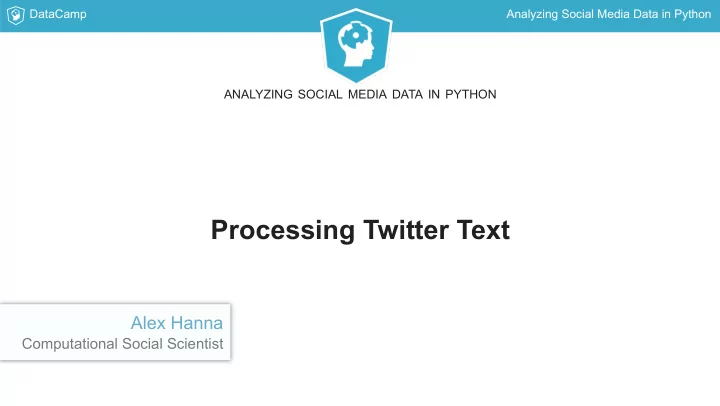

DataCamp Analyzing Social Media Data in Python ANALYZING SOCIAL MEDIA DATA IN PYTHON Processing Twitter Text Alex Hanna Computational Social Scientist
DataCamp Analyzing Social Media Data in Python Text in Twitter JSON tweet_json = open('tweet-example.json', 'r').read() tweet = json.loads(tweet_json) tweet['text']
DataCamp Analyzing Social Media Data in Python More than 140 characters tweet['extended_tweet']['full_text']
DataCamp Analyzing Social Media Data in Python Retweets and quoted tweets tweet['quoted_status']['extended_tweet']['full_text']
DataCamp Analyzing Social Media Data in Python Textual user information tweet['user']['description'] tweet['user']['location']
DataCamp Analyzing Social Media Data in Python Flattening Twitter JSON extended_tweet['extended_tweet-full_text'] = extended_tweet['extended_tweet']['full_text']
DataCamp Analyzing Social Media Data in Python Flattening Twitter JSON tweet_list = [] with open('all_tweets.json', 'r') as fh: tweets_json = fh.read().split("\n") for tweet in tweets_json: tweet_obj = json.loads(tweet) if 'extended_tweet' in tweet_obj: tweet_obj['extended_tweet-full_text'] = tweet_obj['extended_tweet']['full_text'] ... tweet_list.append(tweet) tweets = pd.DataFrame(tweet_list)
DataCamp Analyzing Social Media Data in Python ANALYZING SOCIAL MEDIA DATA IN PYTHON Let's practice!
DataCamp Analyzing Social Media Data in Python ANALYZING SOCIAL MEDIA DATA IN PYTHON Counting words Alex Hanna Computational Social Scientist
DataCamp Analyzing Social Media Data in Python Why count words? Basic step for automation of text analysis Can tell us how many times a relevant keyword is mentioned in documents in comparison to others In exercises: #rstats vs #python
DataCamp Analyzing Social Media Data in Python Counting with str.contains str.contains pandas Series string method Returns boolean Series case = False - Case insensitive search
DataCamp Analyzing Social Media Data in Python Companies dataset > import pandas as pd > tweets = pd.DataFrame(flatten_tweets(companies_json)) > apple = tweets['text'].str.contains('apple', case = False) > print(np.sum(apple) / tweets.shape[0]) 0.112
DataCamp Analyzing Social Media Data in Python Counting in multiple text fields > apple = tweets['text'].str.contains('apple', case = False) > for column in ['extended_tweet-full_text', 'retweeted_status-text', 'retweeted_status-extended_tweet-full_text']: apple = apple | tweets[column].str.contains('apple', case = False) > print(np.sum(apple) / tweets.shape[0]) 0.12866666666666668
DataCamp Analyzing Social Media Data in Python ANALYZING SOCIAL MEDIA DATA IN PYTHON Let's practice!
DataCamp Analyzing Social Media Data in Python ANALYZING SOCIAL MEDIA DATA IN PYTHON Time Series Alex Hanna Computational Social Scientist
DataCamp Analyzing Social Media Data in Python Time series data sum person date 2012-10-23 01:00:00 314 Obama 2012-10-23 01:01:00 369 Obama 2012-10-23 01:02:00 527 Obama 2012-10-23 01:03:00 589 Obama 2012-10-23 01:04:00 501 Obama ...
DataCamp Analyzing Social Media Data in Python Converting datetimes > print(tweets['created_at']) 0 Sat Jan 27 18:36:21 +0000 2018 1 Sat Jan 27 18:24:02 +0000 2018 2 Sat Jan 27 18:09:14 +0000 2018 ... > tweets['created_at'] = pd.to_datetime(tweets['created_at']) > print(tweets['created_at']) 0 2018-01-27 18:36:21 1 2018-01-27 18:24:02 2 2018-01-27 18:09:14 ... > tweets = tweets.set_index('created_at')
DataCamp Analyzing Social Media Data in Python Keywords as time series metrics > tweets['google'] = check_word_in_tweet('google', tweets) > print(tweets['google']) created_at 2018-01-27 18:36:21 False 2018-01-27 18:24:02 False 2018-01-27 18:30:12 False 2018-01-27 18:12:37 True 2018-01-27 18:11:06 True .... > print(np.sum(tweets['google'])) 247
DataCamp Analyzing Social Media Data in Python Generating keyword means > mean_google = tweets['google'].resample('1 min').mean() > print(mean_google) created_at 2018-01-27 18:07:00 0.085106 2018-01-27 18:08:00 0.285714 2018-01-27 18:09:00 0.161290 2018-01-27 18:10:00 0.222222 2018-01-27 18:11:00 0.169231
DataCamp Analyzing Social Media Data in Python Plotting keyword means import matplotlib.pyplot as plt plt.plot(means_facebook.index.minute, means_facebook, color = 'blue') plt.plot(means_google.index.minute, means_google, color = 'green') plt.xlabel('Minute') plt.ylabel('Frequency') plt.title('Company mentions') plt.legend(('facebook', 'google')) plt.show()
DataCamp Analyzing Social Media Data in Python ANALYZING SOCIAL MEDIA DATA IN PYTHON Let's practice!
DataCamp Analyzing Social Media Data in Python ANALYZING SOCIAL MEDIA DATA IN PYTHON Sentiment Analysis Alex Hanna Computational Social Scientist
DataCamp Analyzing Social Media Data in Python Understanding sentiment analysis Method Counting positive/negative words in the document Assessing positivity/negativity of the whole document Uses Analyzing reactions to a company, product, politician, or policy
DataCamp Analyzing Social Media Data in Python Sentiment analysis tools VADER SentimentIntensityAnalyzer() Part of Natural Language Toolkit ( nltk ) Good for short texts like tweets Measures sentiment of particular words (e.g. angry, happy) Also considers sentiment of emoji ( ) and capitalization (Nice vs NICE)
DataCamp Analyzing Social Media Data in Python Implementing sentiment analysis from nltk.sentiment.vader import SentimentIntensityAnalyzer sid = SentimentIntensityAnalyzer() sentiment_scores = tweets['text'].apply(sid.polarity_scores)
DataCamp Analyzing Social Media Data in Python Interpreting sentiment scores Reading tweets as part of the process Does it have face validity ? (i.e. does this match my idea of what it means to be positive or negative?)
DataCamp Analyzing Social Media Data in Python Interpreting sentiment scores tweet1 = 'RT @jeffrey_heer: Thanks for inviting me, and thanks for the lovely visualization of the talk! ...' print(sid.polarity_scores(tweet1)) {'neg': 0.0, 'neu': 0.496, 'pos': 0.504, 'compound': 0.9041} tweet2 = 'i am having problems with google play music' print(sid.polarity_scores(tweet2) {'neg': 0.267, 'neu': 0.495, 'pos': 0.238, 'compound': -0.0772}
DataCamp Analyzing Social Media Data in Python Generating sentiment averages sentiment = sentiment_scores.apply(lambda x: x['compound']) sentiment_fb = sentiment[check_word_in_tweet('facebook', tweets)] .resample('1 min').mean() sentiment_gg = sentiment[check_word_in_tweet('google', tweets)] .resample('1 min').mean()
DataCamp Analyzing Social Media Data in Python Plotting sentiment scores plt.plot(sentiment_fb.index.minute, sentiment_fb, color = 'blue') plt.plot(sentiment_g.index.minute, sentiment_gg, color = 'green') plt.xlabel('Minute') plt.ylabel('Sentiment') plt.title('Sentiment of companies') plt.legend(('Facebook', 'Google')) plt.show()
DataCamp Analyzing Social Media Data in Python ANALYZING SOCIAL MEDIA DATA IN PYTHON Let's practice!
Recommend
More recommend